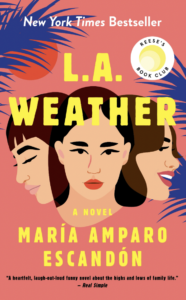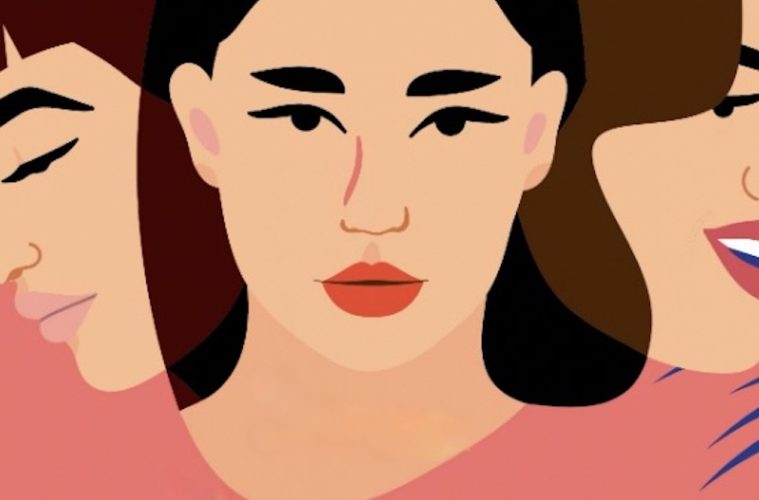
L.A. Weather (Courtesy Maria Amparo Escandón/Flatiron Books)
Maria Amparo Escandón clearly loves Los Angeles as much we do and her new book L.A. Weather (Flatiron Books) conveys the complexities of the city that don’t always make it easy, especially as a Chicana. Escandón shares an intimate glimpse into Mexican family life, filled with tradition, music, food and love.With a diary format, the absorbing tale follows the struggles of the Alvarado family, delving into the lives of parents Oscar and Keila and their three grown daughters Claudia, Olivia and Patricia as they navigate the city and their careers– as a chef, an architect and a social-media expert, respectively.
Already a New York Times bestseller, the book’s look at upper middle class Mexican-Americans in 2016 (during the drought era) is unique yet relatable, serving an easy to absorb portrait that’s appealing to a variety of cultures. There’s also a Spanish language edition called El Clima De Los Angeles.
Escandón will be at the Skirball Cultural Center on October 11 for “L.A. Weather: Latinas in Los Angeles,” hosted by Beatriz Acevedo, Latina entrepreneur and motivational speaker. Escandon and Acevedo plan to discuss the Latina experience in Los Angeles as captured in the book.
As a native “LA-tina” ourselves, we must say, she’s an inspiration and this is a great book to read for Hispanic Heritage Month, or anytime. Escandón and her publisher Flatiron Books provided us with an exclusive excerpt from L.A. Weather (L.A. Weekly even gets a shout-out) to share.
As Lola drove up and down the hills of Highland Park, the neighborhood she’d lived in for the past thirty-seven years, she could easily distinguish which houses had been bought and renovated to be sold at twice the price and which ones hadn’t yet: that one over there still had its patina, the charm of an old garden populated with gnomes and swans and Catholic saints, a wrought-iron fence and lightly chipped paint on the walls. That other one with the Tesla parked in the driveway sparkled with newness, surrounded by a water-wise garden, a bright red front door and a fence built with horizontal cedar slats. She wondered which of those new houses Olivia had transformed, sending the longtime tenants to live where the wind faded into oblivion, the only place where they could afford rent.
As she drove down the main drag, Figueroa Street, she counted the few landmarks and establishments that had survived—for the time being—her neighborhood’s dizzying transformation from a quaint old Latino enclave into “America’s hottest neighborhood,” at least according to L.A. Weekly. She found a parking spot in front of the flower shop and squeezed her bright yellow, lightly dinged Honda Fit in the small space and waved at her friend Susana, the florist, through her storefront window. She’d babysat for her years ago. Five boys; all grown, but still to this day one or another would stop by and bring her gifts, like a live turkey that instead of food became a pet, a sack of yams that she gave away, a fuchsia rebozo that she loved and used only on special occasions. Susana opened the door and yelled, “Lola! Come over for dinner tonight! The boys are in town and will want to see you. Seven o’clock?”
“I’ll bring tamales costeños,” shouted Lola as she walked past. Her meeting with a Legal Aid lawyer was only a few blocks away, so she headed down Figueroa in the direction of York Avenue, walking past La Fuente restaurant (their sopa de albóndigas was a dish she’d raved about on Yelp). She never ordered delivery; she preferred take-out just to have a chance to get a glimpse of Chicken Boy, the old, bizarre statue towering over the street, perched on the next door neighbor’s rooftop. It always made her smile, all the weirdness that L.A. had to offer, if you knew where to look. She wished Chicken Boy would stay there forever. But she knew it was doomed: prospectors, speculators, flippers, and developers were quickly taking over her neighborhood right in front of her eyes. It was becoming a playground for affluent hipsters: there they were, eating at Martha’s, her favorite taco place, or spending their money at Verde, the organic juice bar, or at Vegan-O, the vegan restaurant next door. She’d seen a new bookshop right next to a 99 Cents Only Store, and Our Daily Bread, a bakery that sold croissants for four dollars. At least that place had preserved a famous mural of the Virgin of Guadalupe painted years before on its storefront. She had fought for that. Forcefully. Not that she was religious. It had been a matter of principle
And now she’d learned that Olivia, the little girl she had helped raise, was contributing to the assault. How could she? She’d always come to her, not her mother, for comfort, until she went to college and Lola moved on. It was painful to accept that the sweet little Olie of her memories had turned out to be—well, the enemy. La pinche enemiga!
She felt light-headed. As she tried to hold on to a lamppost she almost got knocked over by a young man gliding by on a skateboard.
When she arrived at Kindness & Mischief, one of those new coffee shops, Kamirah Jones, flaunting a burst of curls the color of raven wings, was already waiting for her. Kamirah was a fierce pro-bono human rights lawyer specializing in eviction defense. She and Lola had become friends years before when Lola first went to seek help at Legal Aid on behalf of one of her neighbors.
“I almost got run over by a man-bun-wearing torpedo,” Lola said, still stunned.
“I’m not surprised. Those people!” said Kamirah, offering Lola a cup of drip coffee and a poppyseed muffin to calm her down. “I got you the same as last time.”
Both women sat to discuss a new case that Lola had brought to her, a ninety-two-year-old widow who’d gotten an illegal eviction notice and had nowhere to go. In the middle of the conversation, Kamirah asked, “You seem upset. What gives?”
“Remember that family I used to nanny for—on the Westside?”
“It was quite a few years ago, right?”
“Right! I used to love working there. They spoke Spanish and cooked Mexican. And the middle girl, Olivia, she was my favorite.” Lola looked guilty for a moment. “I wasn’t supposed to have favorites, but she just won me over on day one when she put together a welcome-to-our-family bouquet from her mother’s roses. I’ll always remember the mom’s face when she recognized her flowers, my flowers! But now this girl is all grown up. She’s an architect, one of those people destroying Highland Park! I only know because she showed up on my doorstep the other day, asking me to come back to take care of her twin girls. Who almost drowned! That’s what you get for having a swimming pool. A goddamn rich people accident,” Lola said. “That would never have happened on my watch!”
“And so?”
“It’s bothering me like a stone in my shoe!”
“Does she know you’re an advocate with us?”
“No. I didn’t tell her. I just wanted her to leave.”

L.A. Weather author María Amparo Escandón (Chris Fortuna)
Editor’s note: The disclaimer below refers to advertising posts and does not apply to this or any other editorial stories. LA Weekly editorial does not and will not sell content.
Advertising disclosure: We may receive compensation for some of the links in our stories. Thank you for supporting LA Weekly and our advertisers.

